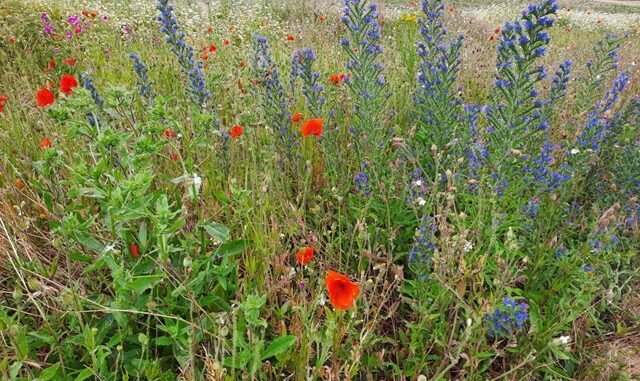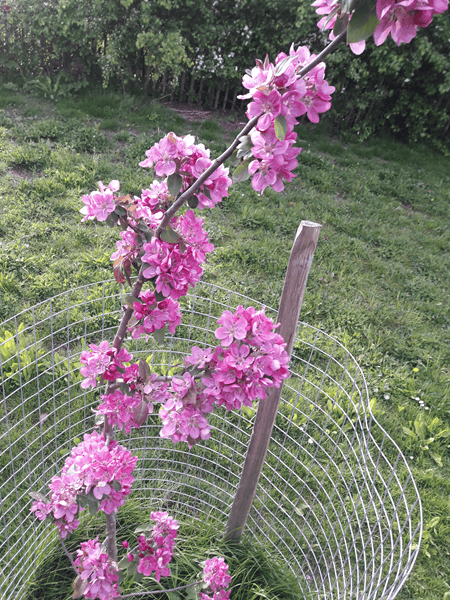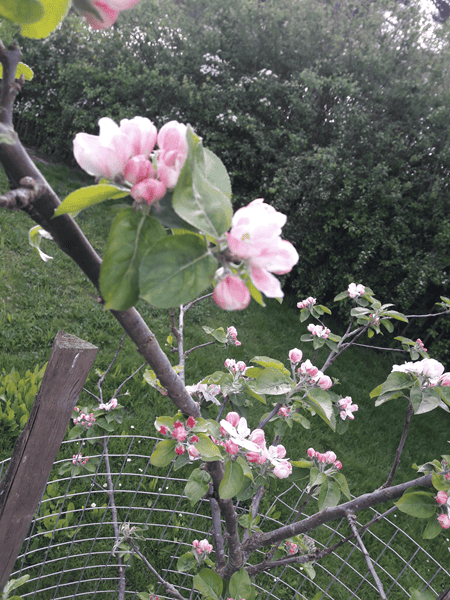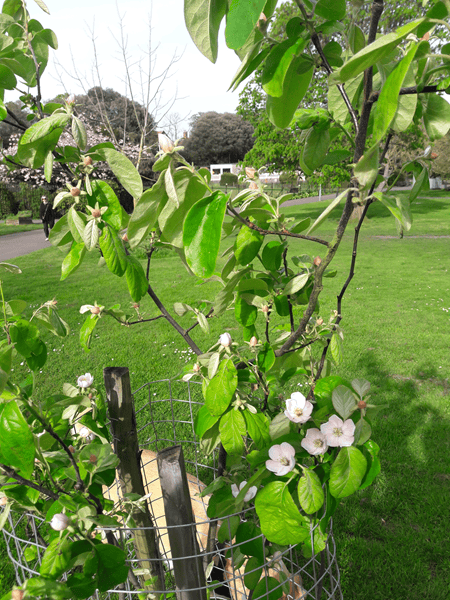
Green Councillor Kevin Pressland is a passionate campaigner for nature and the natural environment. His understanding of the threats faced by the natural world is based on expertise gained from a 40-year career in horticulture, garden design and sustainable land management:
Now in its third year, the Linear Heritage Orchard at Ellington Park is beginning to develop well, combining apples, pears, medlars and quinces with a developing wildflower meadow underneath, creating an attractive margin to the boundaries of the wildlife garden.
Last year the wildflower meadow had its first Vipers Bugloss. This plant has stunning flowers and is often quite illusive.
Some people have deemed the large rosette forming plants chicory and hawkweed in the meadow as unattractive however these will create a wow factor when in flower and I urge these people to be patient and realise that perceived untidiness is not untidy in nature but has within it, much beauty to behold.
Chicory and hawkweed plants attract hoverflies, beetles, long tongued bumblebees and honeybees, butterflies etc. As a society we are slowly beginning to realise pollinator numbers have decreased substantially, surely all of us have an obligation to counter this decline for our own sakes if not anything else as we are part of nature not separate and we rely on nature’s services.
The heritage fruit in the linear orchard includes:

Apple ‘Sop in Wine’ ‘, is a very old English variety that makes a pleasant aromatic eating apple and a good contribution to a traditional cider blend. It has particularly attractive dark pink blossom and crimson fruits with pink stained flesh, giving it an ornamental quality too; even the wood has a deep pink stain.
Apple ‘Howgate Wonder’, a cross between ‘Newton Wonder and ‘Blenheim Orange’ apple cultivars – this variety produces huge cooking apples with a gorgeous sweet flavour. Fruits stay firm and do not collapse when cooked. Popular variety for showing due to the size of the fruits.

Apple ‘Ellisons Orange’ is a crisp and juicy mid-season apple with a very unique aniseed flavour. It is a rich, intense and complex taste that owes much to its parent tree, Cox’s Orange Pippin. A good substitute for the more disease-prone Cox’s Orange Pippin, this is a very interesting apple to grow and makes excellent juice.
Medlar trees (Mespilus germanica) are easy to grow, productive, generally problem-free and need little pruning. They produce large white flowers in late spring, followed by small rounded fruits (about 5cm/2in across) for picking in autumn, and fiery-tinted autumn foliage. Medlar fruits are a curious delicacy, popular in medieval times but now not widely grown. Harvested in autumn when usually still hard, bitter and unripe, the small golden-brown fruits need to be stored for several weeks to ripen (or blet) until they are dark brown, soft, sweet and aromatic. They can then either be eaten (traditionally with cheese and port) or, more popularly, used to make a fragrant amber jelly to accompany rich meats. They can also be used in sweet desserts.

Quince (Cydonia oblonga Vranja’), is a beautiful single variety quince that produces sweet-smelling flowers and large showy fragrant fruit, golden-yellow when ripe. The Royal Horticulture Society has given Vranja the Award of Garden Merit. A small deciduous tree, a popular choice for its strong, upright habit. Its leaves are grey-green with a fluffy texture beneath, and they turn an attractive buttery yellow before falling in autumn. Beautiful pale pink flowers appear in May. They are bowl-shaped and showy measuring up to 5 cm across. These blooms turn into the pale green fruits that gradually sun-ripen into golden-yellow quince in late autumn. They are extremely fragrant and attractive fruits.
We ask people to wait till the fruit develops before picking and take in moderation so as many people as possible can enjoy. This is after all a community orchard, you know when fruit is ripe if it drops in the hand after a gentle twist, if it does not leave the fruit there and let it ripen.

You can create a small orchard using the vertical elements of your garden, fences, walls etc and train them in espalier or fan trained form or you could plant a couple of trees on dwarf or semi dwarf rootstocks in small gardens. These rootstocks determine the vigour of the tree and any good plant nursery can advise you on this like Botany Bay Plants near Northdown Park, Margate with knowledgeable horticulturalists in charge.
A single fruit tree, a self-pollinating cultivar like James Grieve, Egremont Russet, Alkmene, Red Falstaff, Scrumptious etc are great for medium sized gardens. You could even grow say 3 or 4 trees on semi dwarfing rootstock which you could then underplant with soft fruit bushes like raspberries, blackcurrants and perennial vegetables like Jerusalem artichokes, rhubarb, common garlic etc so you can have on the doorstep produce at certain times of the year whilst not taking up too much space. Simpler do it the no dig (minimum dig) method and use soaked cardboard to mulch the surface and cover with leaf mould or other compost this will suppress weed growth as the perennial plants are establishing. Why not have a try?

